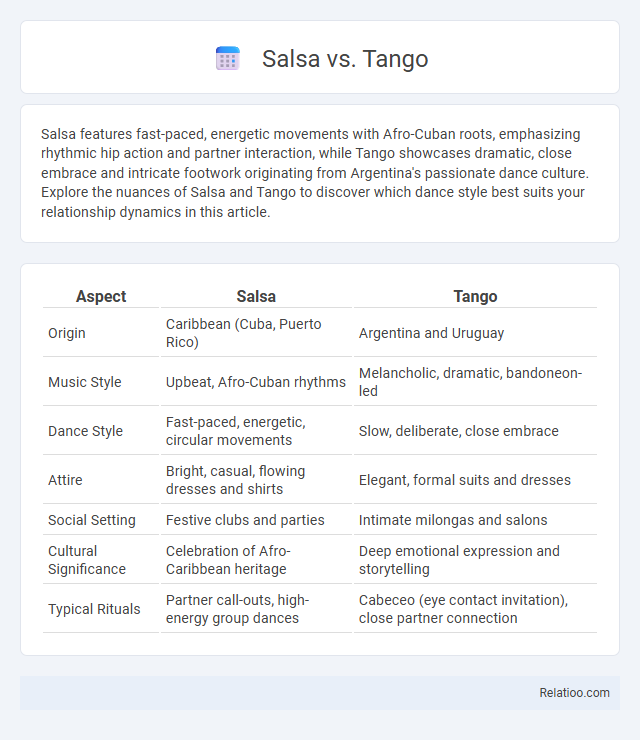Salsa features fast-paced, energetic movements with Afro-Cuban roots, emphasizing rhythmic hip action and partner interaction, while Tango showcases dramatic, close embrace and intricate footwork originating from Argentina's passionate dance culture. Explore the nuances of Salsa and Tango to discover which dance style best suits your relationship dynamics in this article.
Table of Comparison
| Aspect | Salsa | Tango |
|---|---|---|
| Origin | Caribbean (Cuba, Puerto Rico) | Argentina and Uruguay |
| Music Style | Upbeat, Afro-Cuban rhythms | Melancholic, dramatic, bandoneon-led |
| Dance Style | Fast-paced, energetic, circular movements | Slow, deliberate, close embrace |
| Attire | Bright, casual, flowing dresses and shirts | Elegant, formal suits and dresses |
| Social Setting | Festive clubs and parties | Intimate milongas and salons |
| Cultural Significance | Celebration of Afro-Caribbean heritage | Deep emotional expression and storytelling |
| Typical Rituals | Partner call-outs, high-energy group dances | Cabeceo (eye contact invitation), close partner connection |
Introduction: Understanding Salsa and Tango
Salsa and Tango are two distinct dance styles rooted in rich cultural histories, each offering unique rhythms and movements that captivate dancers worldwide. Salsa, originating from Afro-Cuban beats, emphasizes energetic, fast-paced footwork and fluid partner connections, while Tango, born in the streets of Argentina, features dramatic, sensual steps and close embraces. Understanding these differences helps you appreciate the essence of each dance and choose the style that resonates with your passion and personality.
Origins and Historical Background
Salsa originated in the Caribbean, primarily Cuba and Puerto Rico, during the early 20th century, blending Afro-Cuban rhythms with jazz and other Latin music influences. Tango emerged in the late 19th century in the working-class neighborhoods of Buenos Aires, Argentina, combining African, Native American, and European musical elements to create its distinctive style. Dance, as a broader category, encompasses diverse cultural expressions worldwide, evolving from ancient rituals and social customs to contemporary forms blending tradition and innovation.
Music Styles and Rhythms
Salsa music features vibrant Afro-Cuban rhythms with clave patterns driving its energetic beats, characterized by syncopated percussion and brass sections that create a lively atmosphere. Tango music centers around a dramatic, melancholic style with a distinctive 2/4 or 4/4 rhythm, often highlighted by bandoneon and string instruments producing sharp, staccato accents. Dance styles reflect these musical differences: salsa dancing emphasizes fast footwork and fluid hip movements aligned with complex rhythmic patterns, whereas tango relies on close partner connection and precise, deliberate steps matching its intense, rhythmic phrasing.
Basic Dance Techniques
Salsa, Tango, and general dance each emphasize distinct basic techniques crucial for mastering their unique styles. Salsa requires precise hip movements, quick footwork, and rhythmic timing to match its energetic beats. Tango demands sharp, deliberate steps, close partner connection, and controlled posture to express its dramatic flair, while fundamental dance techniques across styles include balance, coordination, and timing to achieve fluid motion.
Key Differences in Movements
Salsa features fast-paced, energetic footwork with quick spins and vibrant hip movements that emphasize rhythm and social interaction. Tango is characterized by its dramatic, sharp, and staccato movements with close partner connection and intricate leg flicks known as "boleos." Dance as a general category encompasses a wide variety of styles, but the key difference lies in Salsa's lively timing and improvisation, Tango's passionate and precise steps, and the broader category's diverse movement vocabulary.
Cultural Significance
Salsa, Tango, and dance in general reflect rich cultural heritages, with Salsa originating in the Afro-Caribbean communities of Cuba and Puerto Rico, embodying vibrant rhythmic patterns and social connection. Tango, rooted in the working-class neighborhoods of Buenos Aires, Argentina, conveys deep emotional storytelling, marked by dramatic movements and intense partner interaction. Dance serves as a universal cultural expression, preserving traditions, fostering community identity, and enabling cross-cultural dialogue worldwide.
Social Dance Environments
Salsa, Tango, and Dance each create unique social dance environments that cater to different interaction styles and cultural backgrounds. Salsa thrives in vibrant, energetic venues where You can engage with fast-paced rhythms and partner improvisation, fostering lively connections. Tango offers a more intimate, improvisational ambiance emphasizing close embrace and subtle communication, while general dance settings vary widely but typically encourage group participation and diverse movement expressions.
Popularity Around the World
Salsa boasts widespread popularity across North and South America, Europe, and Asia, with millions of enthusiasts drawn to its energetic rhythms and social dance scenes. Tango holds a strong cultural presence particularly in Argentina and Uruguay, gaining international acclaim through festivals and dance competitions that celebrate its passionate style. Your choice of dance often depends on regional trends, with Salsa leading in global participation while Tango remains iconic for its rich heritage and elegance.
Choosing Between Salsa and Tango
Choosing between Salsa and Tango depends on your preference for rhythm and style; Salsa offers energetic, fast-paced beats with vibrant hip movements, while Tango emphasizes dramatic, intimate, and precise footwork. Your dance experience level and the social atmosphere you seek also influence this decision--Salsa thrives in lively party settings, whereas Tango fosters close connection in a more formal environment. Understanding these differences helps you select the dance that best matches your personality and goals.
Conclusion: Which Dance Suits You?
Salsa suits those who enjoy energetic, rhythmic movements and social dance environments, emphasizing fast footwork and hip action. Tango appeals to dancers seeking a passionate, dramatic style characterized by close embraces and intricate leg techniques. Your personal preference for tempo, connection, and style will determine which dance best matches your personality and physical expression.

Infographic: Salsa vs Tango
 relatioo.com
relatioo.com